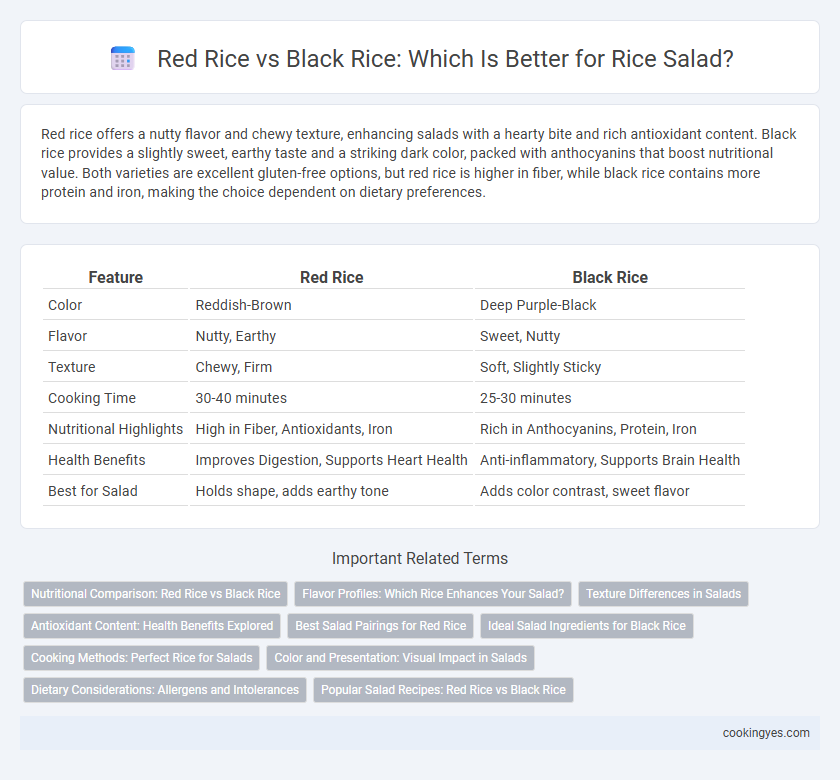Red rice offers a nutty flavor and chewy texture, enhancing salads with a hearty bite and rich antioxidant content. Black rice provides a slightly sweet, earthy taste and a striking dark color, packed with anthocyanins that boost nutritional value. Both varieties are excellent gluten-free options, but red rice is higher in fiber, while black rice contains more protein and iron, making the choice dependent on dietary preferences.
Table of Comparison
| Feature | Red Rice | Black Rice |
|---|---|---|
| Color | Reddish-Brown | Deep Purple-Black |
| Flavor | Nutty, Earthy | Sweet, Nutty |
| Texture | Chewy, Firm | Soft, Slightly Sticky |
| Cooking Time | 30-40 minutes | 25-30 minutes |
| Nutritional Highlights | High in Fiber, Antioxidants, Iron | Rich in Anthocyanins, Protein, Iron |
| Health Benefits | Improves Digestion, Supports Heart Health | Anti-inflammatory, Supports Brain Health |
| Best for Salad | Holds shape, adds earthy tone | Adds color contrast, sweet flavor |
Nutritional Comparison: Red Rice vs Black Rice
Red rice contains higher levels of magnesium and iron, supporting muscle function and oxygen transport, while black rice is rich in anthocyanins, powerful antioxidants that reduce inflammation and improve heart health. Both varieties offer substantial fiber content for digestive health, but black rice typically provides more protein per serving, beneficial for muscle repair and satiety. Choosing between red rice and black rice for salads depends on prioritizing greater antioxidant intake or enhanced mineral content.
Flavor Profiles: Which Rice Enhances Your Salad?
Red rice offers a nutty, earthy flavor with a slightly chewy texture that complements fresh vegetables and vinaigrettes in salads, enhancing their natural taste. Black rice provides a mildly sweet, robust flavor with a tender bite, adding depth and a vibrant color contrast to greens and creamy dressings. Choosing between red and black rice depends on whether you prefer a more rustic, hearty profile or a subtle sweetness that elevates salad complexity.
Texture Differences in Salads
Red rice offers a firm, slightly chewy texture that holds up well in salads, providing a satisfying bite. Black rice has a denser, stickier consistency with a subtle nuttiness that adds a creamy element to the dish. The contrasting textures of red and black rice can enhance the mouthfeel of salads, depending on the desired outcome.
Antioxidant Content: Health Benefits Explored
Red rice contains high levels of anthocyanins and proanthocyanidins, potent antioxidants that help reduce inflammation and oxidative stress. Black rice boasts even greater antioxidant capacity due to its rich concentration of anthocyanins, which may support heart health and improve brain function. Incorporating either red or black rice in salads enhances nutritional value by providing essential antioxidants that combat free radicals and promote overall wellness.
Best Salad Pairings for Red Rice
Red rice offers a nutty flavor and chewy texture that pairs exceptionally well with fresh vegetables like cucumber, bell peppers, and cherry tomatoes in salads. Its earthy taste complements protein-rich additions such as grilled chicken, tofu, or chickpeas, enhancing the overall nutritional profile. Incorporating herbs like cilantro, mint, and a tangy lemon vinaigrette elevates red rice salad combinations for a vibrant and wholesome meal.
Ideal Salad Ingredients for Black Rice
Black rice pairs exceptionally well with crunchy vegetables such as bell peppers, cucumbers, and carrots, enhancing both texture and flavor in salads. Rich in antioxidants and anthocyanins, black rice complements fresh herbs like cilantro and mint, along with citrus-based dressings that balance its nutty taste. Incorporating protein sources like grilled chicken, tofu, or edamame creates a nutrient-dense, satisfying black rice salad perfect for health-conscious meals.
Cooking Methods: Perfect Rice for Salads
Red rice requires longer cooking times and benefits from soaking to achieve a tender yet firm texture, ideal for salads that need distinct grain separation. Black rice cooks faster than red rice and absorbs more water, resulting in a slightly sticky consistency that adds a chewy texture and deep color contrast to salad presentations. Both varieties retain their nutritional value when cooked using the absorption method with controlled water levels to prevent mushiness and ensure each grain remains intact for an appealing salad base.
Color and Presentation: Visual Impact in Salads
Red rice features a warm, reddish-brown hue that adds an earthy, rustic appeal to salads, enhancing visual warmth and texture contrast. Black rice boasts a deep purple-black color that creates striking, dramatic presentation with a glossy, jewel-like finish, elevating salad aesthetics. Combining red and black rice in salads enriches color diversity and visual interest, making dishes more appetizing and vibrant.
Dietary Considerations: Allergens and Intolerances
Red rice contains higher fiber and magnesium levels, making it suitable for individuals with mild gluten intolerance, while black rice is rich in antioxidants and iron, benefiting those with inflammatory conditions. Both types are naturally gluten-free, reducing allergen concerns for celiac patients, but red rice may cause digestive issues in sensitive individuals due to its bran content. Black rice's higher anthocyanin content supports gut health, making it a preferred choice for salads in allergy-conscious diets.
Popular Salad Recipes: Red Rice vs Black Rice
Red rice offers a nutty flavor and chewy texture that enhances grain-based salads like Mediterranean quinoa or vegetable bowls, providing a rich source of antioxidants and fiber. Black rice, known as forbidden rice, stands out in salads due to its slightly sweet, earthy taste and striking dark color, making it ideal for Asian-inspired salads with fresh herbs and citrus dressing. Both varieties boost nutritional value while adding unique visual appeal and depth to popular salad recipes.
Red Rice vs Black Rice for Salad Infographic

 cookingyes.com
cookingyes.com